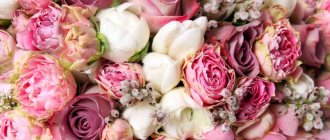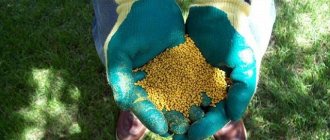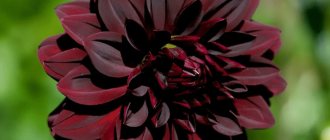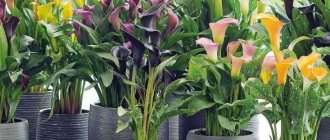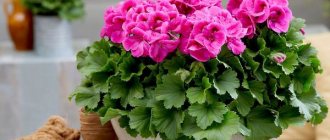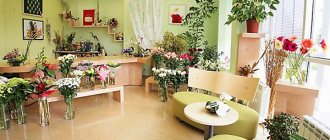What is this
Stabilization is a method when plant juices are replaced with preservation solutions prepared using a special technology. They inhibit the processes of withering and cell breakdown. Glycerin, wax, and gelatin are often used to prepare solutions. However, there are other stabilization methods.
The solutions are used to saturate the entire body of the plant - stem, leaves, flowers. As a result of saturation of fabrics, texture, shape and “look” are preserved. The petals and leaves of flowers that have undergone stabilization are, as a rule, as soft and elastic as those of freshly picked counterparts.
Most often, the stabilizing solution makes the natural color and aroma of the inflorescences less bright. They are restored with the help of aromatic oils and special coloring agents.
The technology for preserving flowers, which has turned into a new trend in floristry, was developed by Jeanette and Paul Lambert, a Belgian and French woman who tied the knot. In the 70s of the 20th century, the couple moved to Kenya, where they founded their own floristic house, Vermont.
Jeannette and Paul have shortened the period of delivery of plants from the plantations to the workshops: at the initial stage, the buds that have blossomed are cut and sorted, and smooth, dense-leaved plants without flaws are selected. Then the flowers are sent to production, where workers preserve them. Specialists ensure that the technology stages are not violated.
Florists widely use preserved flowers. They decorate banquet halls, restaurants and cafes, shopping areas, hotel lobbies, etc. with them. Stabilized plants are used to create interior compositions; they look great on gift packages. Flowers that have undergone stabilization methods do not need to be watered, illuminated in a special way, or replanted.
Comparison with other color fixation technologies
There are three ways to stabilize a flower - wax, glycerin or hairspray. Florists who professionally fix flowers keep secret compositions that allow plants to be preserved for a long time. And yet, even roses made by yourself can last quite a long time.
Method 1 – fixation with wax. One of the simplest methods is to immerse the flower in melted wax and then immediately into cold water.
This allows you to fix large and dense buds. It is important that the wax touches all parts of the flower, especially the petals. The disadvantage of this method is that such a rose in a flask cannot be exposed to direct sunlight and high temperatures, since the wax can melt and ruin the composition
Wax also imparts a matte appearance and partially reduces the brightness of the bud color.
Method 2 – fixation with varnish. A longer, but not the most reliable way to stabilize a flower. Excess petals that will interfere with subsequent fixation are removed from the bud. The flower is placed for a week in a container with semolina or rice. Some masters place the flower in salt, but it strongly draws moisture onto itself, and the flower dries out. The same goes for silica gel. Then the plant is sprayed with hairspray, possibly in several layers, and hung to dry with the bud down for several hours.
Method 3 – fixation with glycerin. The most reliable, it allows you to literally preserve a plant and stop its time, but it also takes the longest to prepare. It consists of replacing the intracellular natural fluid inside the plant with glycerin. The plant, freshly cut and slightly dried for several hours, is placed with a cut of the stem in a solution of glycerin and water in a 1:1 ratio. If desired, you can add dye, especially if the flower is white, and the petals will take on an unusual color. The stem should be several centimeters longer than the intended flask, since every two days part of the stem is cut off directly in the solution. The flower stands for about two weeks.
Preserving flowers in gelatin and salt
If for some reason you were unable to get glycerin, you can replace it with more affordable products - salt and gelatin, or rather, a very strong solution based on these ingredients.
For 100 g of hot water you will need 25 g of gelatin and 2 tbsp. table salt. The solution is prepared simply: pour water into gelatin, let it brew, add salt. Then this solution is filled with a container in which prepared flowers, beads, ribbons and other decorations were previously placed. Until it hardens completely, place the container in a cool, dark place.
You can add your favorite essential oil or any other flavoring to the solution.
Also, if you are going to store the preserved flowers in a closed container, you can prepare a very strong salt solution and pour it over them. But be prepared for the fact that their color will change, and any violation of the seal will ruin the craft.
See also: How to open an quest room in your city? Business plan for an quest room with calculations of how much it costs
Stabilizing flowers at home
Having mastered the skills of stabilizing flowers, you can create extraordinary bouquets with your own hands that can easily decorate your apartment, workplace, or country house. Preserved plants are suitable for gifts. Of course, today you can buy an inexpensive bouquet or a chic arrangement at any time, but no one has canceled your crazy hands... Try to make a floral present yourself.
Choose…
In addition to fresh flowers, small trees and bushes can be stabilized. They are as decorative as plants in pots, while keeping the crown dense throughout the year. Diseases and pests will bypass such flowers.
When considering which flowers to immortalize, carefully examine the leaves and stems of the candidates. These parts must be strong - the stronger, the longer the preserved plant will last without losing its original appearance. Choose flowers with thick stems and petals that can withstand the elements.
It is worth finding out in advance how well the plant tolerates stabilization. It happens that the same representative of the flora of different varieties reacts differently to the procedure. One becomes unusable already during conservation, and the second brings joy to the owner for a long, long time.
Source: m.russian.alibaba.com
Glycerin is the best way to extend the life of a plant.
Glycerin is a transparent, non-toxic, trihydric alcohol soluble in water. It is distinguished by increased hygroscopicity, that is, when in contact with air, glycerin absorbs a lot of moisture.
The substance evaporates slowly at room temperature. An aqueous solution of glycerin is used to preserve flowers. Penetrating through the stems to the plant cells, it fills them, preventing moisture from being lost.
There are two ways to preserve flowers using glycerin, which are used at home.
First way:
First you need to cut a plant whose stem length does not exceed 50 centimeters. A rose or lily would be ideal. It is necessary to keep the flower in a horizontal position for four to five hours. This is done so that the moisture evaporates. You need to make sure that the plant does not wilt. After this, glycerin is mixed with water in a one-to-one ratio and the flower stem is placed in the resulting solution. You can tint the liquid with brilliant green or food coloring to give the plant a rich shade.
It is necessary to cover the container with a cloth. Thanks to this, less liquid evaporates. Place the vessel in a dark, dry place. It is necessary to add the solution to maintain its original level and make cuts on the stem within a week, facilitating the flow of essence into the pores of the plant. You will have to wait 21 days for the flower to stabilize. At the end of the procedure, you need to take out the “preservative” and hang it vertically to dry.
The new accessory is ready! You can give it to someone as a gift, or put it on a shelf in your room. The plant kept in a glycerin solution is stored for a whole year.
In the second method of stabilization in glycerin, a solution diluted in a ratio of one to two is used. The mixture must be heated to 70°C, after which a flower with the cut end of the stem should be placed in it.
The procedure lasts two weeks, if plants with large buds are taken - three. To make the solution absorb better, you can divide the end of the stem into two halves and remove the skin from it. This stabilization method is also suitable for autumn tree branches and spruce legs.
Benefits of Glycerin:
- inflorescences and leaves retain their beauty for a long time;
- the stabilization composition does not harm the environment and the human body;
- preserved flowers are elastic, with a glossy sheen.
Disadvantages of glycerin:
- preservation lasts a long time;
- Flowers with thick stems and strong petals are suitable for the procedure;
- darkening of the petals is possible.
Tip : to keep preserved plants in their original appearance even longer, place them in a glass flask. A closed space guarantees protection from moisture and dust.
Compositions of stabilized flowers
Using the above stabilization methods at home, you can make original compositions from plants. Of course, they will not retain a fresh look for several years, as in industrial production, but they will be able to decorate rooms for several months.
In a flask
A composition of flowers and leaves in a flask is an excellent interior decoration.
The glass cap protects the stabilized plants from external influences, prolonging their life. Recommended by topic
TOP 25 Most unpretentious indoor plants How to revive a home flower: drying, frozen, flooded at home 23 Houseplants that purify the indoor air
A rose or a bouquet of several flowers on a stand under a glass bulb looks great. To create an arrangement, plant stems are cut at the desired height, laid on a dry surface or hung vertically with the bud down to reduce moisture content. Then stabilization is carried out using one of the methods described above.
To install the bouquet, prepare a stand from a suitable material, for example wood or plastic. It can be round or polygonal in shape. The composition is covered with a flask to protect the flowers from dust, water droplets and other substances. A recess is made on the surface of the stand for a better fit of the glass cover. Also, this gutter will not allow the flask to move and damage the composition or fall and break if accidentally tilted.
Paintings from stabilized flowers
Paintings with stabilized plants look like a corner of wildlife.
Plants that have undergone stabilization are often used to create paintings. It can be a landscape, still life or even a portrait. Plant material, depending on the idea of the composition, is used both to decorate the entire canvas and to give greater expressiveness to a certain part of it.
To work, you need a base (a sheet of cardboard, plywood or polystyrene foam), stabilized flowers, double-sided tape, and a glue gun. A variety of plant materials are selected for paintings - not only flowers, but also moss, leaves of different sizes, shapes, and colors.
Branches of both coniferous and other evergreen and deciduous trees and shrubs, fruits, including acorns, cones, nuts, dried bunches of viburnum, rowan, and pieces of bark may be useful.
First of all, a sketch of the future image is made on a sheet of paper, then its contours are applied to the base. Carefully consider the placement of individual herbal ingredients. Moss is suitable for displaying grass on the forest edge, front lawn, and along the banks of a river. From fern leaves you can assemble a lush bush, and with the help of small branches you can create a tree. If desired, the picture is complemented with artificial fruits.
To fix light objects - flowers, leaves, moss, use double-sided tape. Heavier ones (fruits, bark, twigs) are attached with a glue gun. The work will be done carefully, excess protruding glue is removed so that it is not noticeable among the plant components. The finished painting is attached to a frame and hung on the wall.
Preserving the plant with paraffin
You can extend the life of a fragrant gift using paraffin. This plant stabilization technique is quite simple. It is enough to have cosmetic wax or an old candle on hand. For this method of preservation, it is better to choose flowers with hollow stems, or use only buds.
Paraffin must be melted in a water bath. Draw the resulting liquid into a syringe - a medical attribute in this case is used without a needle. You need to carefully inject the contents into the peduncle or stem of the plant, evenly filling the internal cavities. Upon completion of the procedure, the flower is hung upside down. In a couple of days it will dry and will delight the owner.
Benefits of paraffin:
- the technology is simple;
- After the procedure, roses, chrysanthemums, tulips, and other representatives of the flora acquire a chic appearance.
Disadvantages of paraffin : the flower does not last long. Within a couple of weeks after paraffin sprays, the leaves will turn yellow and the buds will begin to fade.
Business Features
The business of producing flowers in glycerin has its own characteristics:
- minimum initial investment;
- low level of competition;
- the opportunity to do business at home;
- low production costs;
- simplicity of technology, to get started you just need to take online courses;
- availability of consumables;
- payback of initial costs in 1-2 months of work;
- growing demand for goods;
- the ability to combine classes with your main job or devote all your free time to business;
- environmental safety of the enterprise; no toxic substances are used during conservation.
Beeswax - assistant to flower longevity
Another simple technology is stabilizing the flower with beeswax. Just as in the first case, we drown the waste product of bees in a water bath, and, without allowing the substance to harden, we immerse the plant in it.
For the procedure to be successful, it is necessary to distribute the wax evenly throughout the flower. To do this, you need to twist the stem around its axis. After treatment, the plant should be hung upside down and wait until the beeswax hardens.
Benefits of Beeswax:
- fast way and excellent results. After being treated with beeswax, the flower will not only delight you with its natural shade, but also with additional shine;
- You can easily brush off the dust covering the leaves.
Disadvantages of Beeswax:
- A week will pass, and the plant will begin to fade - fade and turn yellow, the leaves will become heavier;
- flowers treated with beeswax are sensitive to the sun.
Source: pixabay.com
Sales channels for flowers in glycerin
For a business to be successful, it is not enough to make beautiful souvenirs - you need to find a buyer. The easiest way to do this is via the Internet. Create accounts on popular social networks, fill them with high-quality useful content, use targeted advertising, collaborate with bloggers who are trusted by your target audience.
You can enter into agreements with shops that sell flowers and souvenirs. But in this case your profit will be less.
It would be a good idea to open an offline store. Costs will increase, but profits will also increase. Revenue can be increased if you hold master classes there for those who want to make an original souvenir with their own hands.
Preservation with hairspray
This is the most affordable way to stabilize a plant. Hairspray can be found in the cabinet of any representative of the fairer sex. It’s good if the curl styling product has a strong hold, although other types are also suitable.
Before you start preserving, you need to dry the flower, especially if we are talking about a freshly cut plant. To do this, you can put it in a container with an airtight lid for several days. Dry moss or activated carbon are placed at the bottom of the container; silica gel or sand are also suitable. When the flower is ready for the procedure, you just need to treat it with varnish, and then make sure that the substance spreads evenly on the petals, stem and leaves.
At the end of spraying, the plant must be dried, placing the bud down and leaving it in this state for a week. In seven days the handsome man will be ready. You can safely use it in decor.
Advantages of varnish conservation:
- simplicity, accessibility;
- the technology does not require special skills and does not take much time.
Disadvantages of varnish conservation:
- within a couple of days the flower will begin to lose its attractive appearance and natural flexibility. The plant will become fragile. It can easily be damaged by accidentally touching a leaf, so it is extremely difficult to sweep away dust from such an object;
- Over time, dark spots will appear on the petals and other parts - a consequence of chemical treatment.
How to preserve flowers in glycerin: useful tips
To preserve flowers in glycerin, follow these simple recommendations:
- Place plants in thoroughly washed containers (you can even sterilize the container before use).
- Wash the flowers to prevent pollen from getting into the container. It makes the solution cloudy.
- Do not touch the composition with your hands - use clean tweezers or wooden sticks.
- Do not keep the composition in the sun - the flowers may turn pale and lose their presentation.
- The fresher the flowers, the better they will be preserved. Therefore, do not use limp or rotten plants for work.
- The readiness of plants is determined by the elasticity of their leaves and the appearance of glycerin droplets at the ends of the petals.
Composition in a glass vessel
An excellent method that is suitable for preserving both individual flowers and compositions or small bushes. Bouquets in an original transparent glass jar can decorate your home or be a good birthday gift. Hand-made is in fashion now!
Before you start canning, you need to sterilize the vessel where the plants will “live”. The jar should be held over steam for several minutes or doused with boiling water. This procedure is mandatory; it helps get rid of germs.
When the vessel is ready, you need to place the plants in it, forming a composition. Fantasy will come to the rescue. You can add twigs with openwork leaves or greenery to the flowers. Pebbles, shells, and beads are suitable as decoration - the main thing is that these small things are resistant to moisture.
Having laid out the composition, the jar is filled with solution. There are several recipes.
First . For preparation you will need glycerin. The substance must be diluted in a ratio of one to two - part glycerin to two parts drinking water. Pour the solution into a jar. After two days it needs to be changed.
Second . It is prepared as follows: sugar and gelatin are dissolved in equal proportions in water, and then left for several hours. Then the composition is heated on the stove, mixed well, and then filtered through cheesecloth and a fine sieve, getting rid of particles that have not dissolved.
Third . A saturated saline solution is also suitable for preserving flowers in a jar.
No matter what composition you choose, do not forget to distribute the flowers harmoniously so that the composition looks neat. When drowning in liquid, plants should not come into contact with each other. Close the container with a lid. It can be decorated with ribbon or twine. The composition is ready!
Advantages of canning:
- bouquets in jars look very advantageous and original;
- plants floating in the solution retain an attractive appearance for a long time;
- conservation technology is simple and does not take much time.
Disadvantages of jar preservation : flowers can only be seen through the glass of the vessel; plants cannot be taken out.
How to make fresh flowers in glycerin
The manufacturing technology is so simple that making fresh flowers in glycerin is not difficult even for those who have no experience. The essence of the technology is that glycerin replaces the cell sap of the plant. Therefore, the flowers are preserved (stabilized) and remain in a “life-like” state for a long time.
You will need:
- the plants you will preserve;
- glycerin solution;
- transparent glassware with stoppers or lids (glasses, bottles, etc.);
- cutting boards;
- knives;
- tweezers;
- decor for decorating the composition.
Rules for making a composition:
- If you make souvenirs from flowers that you grow yourself, cut them at an angle with a sharp knife, preferably in dry, cool weather.
- Prepare a preservative solution: take two parts boiling water to one part glycerin. Let it cool.
- Place the flowers in a glass vessel, leaving free space - this way the composition will look more harmonious. Make sure the flowers are clean: free of dust and rotten leaves.
- Fill the flowers with cold solution and put the container in a dark place. As the solution is absorbed into the plants, add the preservative mixture. Glycerin will gradually replace the plant sap. When the amount of glycerin stops decreasing, the flowers are ready. If the solution has darkened, drain it, rinse the flowers with running water, put it back in the container and fill it with a new portion of the solution.
- Decorate the product with decorative stones, shells, ribbons, etc.
The stabilization process can last from several days to several months. This depends on the plant's ability to absorb glycerin and the size of the composition.
Plants with thick stems are suitable for storage in glycerin: carnations, asters, orchids, chrysanthemums, etc.
Preparatory stage
Before you start creating stabilized flowers with your own hands, the plants need to be prepared. During the process, you must adhere to the following rules.
- Plants need to be cut at an acute angle. The cut line should be neat and even. The stem of a flower can be either long or short.
- Before processing, prepared plants should be left in a warm and dry place for a couple of hours. During this time, surface moisture will evaporate. You should not leave the plant to dry all night, otherwise it will begin to wither. Damaged flowers cannot be embalmed.
- Dried leaves must be carefully cut off from the stem of the prepared plant. The thorns of roses are also cut off. This can be done with a sharp knife.
- The container into which the solution or melted wax is poured must be clean. Using dirty dishes will cause the flowers to become moldy.
Making a flavoring
Making your own fragrance is quite simple, but it will look original and fill the house with an aroma that you choose yourself.
For this we need:
- 25 g gelatin;
- 100 ml hot water;
- 2 tablespoons of water;
- essential oil (to your taste).
Mix gelatin with hot water and add salt. When this solution is ready, you need to add essential oil there at the rate of 10 drops per 2 cups of liquid. However, if you want to achieve a stronger aroma and you like such smells, then feel free to add more.
Preserved flowers can be not only a beautiful decoration, but also an excellent gift. Making them is not at all difficult, and they will delight you for many years.
How long does a stabilized plant live?
How long the flower will retain its attractive appearance depends on the preservation method. Care also plays an important role. If a stabilized plant is kept in a glass flask, it will last up to ten years, and without such protection no more than two.
Plants that have undergone the conservation procedure do not require special care. The main thing is to keep them out of the sun, make sure they don’t get wet, and treat them from dust with a soft sponge or hairdryer, setting the device to a cold air flow. The product should be kept away from fire as it is easily flammable.
If the flowers are placed in a glass flask, then you can treat the outside with window cleaner. An unprotected plant should be kept in a room with a humidity of 60-80%. At lower humidity, the flowers will become brittle; at high humidity, they will absorb a lot of water and deteriorate. The temperature in the room where the flowers are located should not be lower than +5 degrees, but not higher than +35.
Stabilized flowers are no different from live ones. They will decorate your home or office, and are also suitable for decorating a holiday table. There are many conservation technologies. With the help of any, you can create an original composition, and if you follow simple rules of care, you can enjoy it for many years.
If something went wrong during the stabilization process, no problem! You can please yourself, family and friends with fresh flowers at any time, for example, by ordering delivery from the Russian Bouquet company.
Plant stabilization technology
The process of flower stabilization is based on the replacement of water in the cells of plants and flowers. Water is replaced by glycerol, which preserves the appearance and structure of plant and flower cells. Remember the many jars of small animals, plants and body parts in your high school biology classroom? It is the ability of glycerin to preserve cells (both living organisms and plants) that underlies the technology of plant preservation.
The medical preparation glycerin exhibits its properties depending on the state of the environment: in a humid environment, the drug draws moisture from the atmospheric air and transfers it to the flower, and in a dry environment it draws moisture from the cells of stems, leaves and flower buds. That is, dry air is needed in the room, in which the process of stabilization and long-term preservation of flowers in the bouquet will take place. In terms of its chemical composition, glycerin is a trihydric alcohol that is highly soluble in water.
Stabilization is suitable for almost any type of plant with relatively long stems: roses, gerberas, chrysanthemums, as well as entire bouquets. You can also use the technique of stabilizing individual branches with flowers or leaves: cherry blossoms, autumn maple leaves.
The only condition for successful stabilization: the flowers must be as fresh as possible so that the stem cells have not yet lost their ability to pass water to the bud cells.
You can create a universal and original gift with your own hands! To stabilize the colors, you will need a solution of glycerin (not to be confused with the drug “nitroglycerin”) and water. Glycerin solution is sold in every pharmacy without a prescription (8-10 rubles per bottle). For one bouquet and a regular vase, 3-4 vials of glycerin will be enough.
- 1. Mix glycerin and water in equal proportions.
- 2. Pour the resulting liquid into a vase.
- 3. Trim the stems of the plants in the bouquet by 1 centimeter.
- 4. Place the bouquet or individual flowers in a vase as you would a regular bouquet. There is no need to cover the flowers from above; the solution will be absorbed through the stem. If you want to preserve an orchid flower, pour the solution into a plastic container (its lid can be easily opened and closed).
- 5. Every day, take out the flowers and trim them one centimeter for 5-7 days.
- 6. Renew the water-glycerin solution and place the flowers for another 5-7 days without additional cutting of the stems.
After stabilization, flowers and plants will retain their shape, but will become very fragile, so stabilized flowers must be stored very carefully and carefully transported so as not to break or crush fragile petals and leaves.
The original color will remain virtually unchanged, only darker. If you want to experiment, then you can add a coloring pigment to the solution or paint already stabilized flowers. For example, an interesting effect can be obtained by stabilizing white flowers with the addition of red or blue dye to a water-glycerin solution.
As a result of tinting, the veins on the petals of the plant will be colored, which will be especially noticeable on white flowers. Danger: do not use potassium permanganate as a tinting component: when glycerin interacts with potassium permanganate, a strong chemical reaction occurs (glycerin catches fire).
Since the natural essential oils of fresh flowers are not preserved in glycerin, stabilized flowers will not have their own natural aroma. But you can use aromatic essential oil to give the bouquet a pleasant scent.
You can store stabilized flowers without water, in an empty vase. Also, stabilized flowers can be used as dried flowers in compositions. It is recommended to clean dust from stabilized flowers using a hairdryer.
Methods of stabilization in industrial conditions
Making such plants is not an easy process. It includes:
- growing crops with dense stems, massive leaves and buds;
- cutting suitable specimens, holding for a couple of hours;
- placing the plant in a container with glycerin;
- treatment of the stem and foliage with a composition that imparts rigidity;
- processing the petals in a similar way, only an aromatic fragrance is added to the composition.
As a result, the flower absorbs glycerin instead of juice, which prevents it from withering; the surface becomes harder without losing its elasticity. An industrially produced flower can last for 5 to 10 years without spoiling (the exact period depends on the crop used and compliance with storage conditions).
Companies engaged in such business have their own secrets regarding the solution used. The methods differ in the percentage of water and glycerin, the addition of certain chemical components, etc. The formula used may vary for different types of flower. For example, in some companies, flowers are embalmed at the growth stage, watered not with water, but with a special composition. They are grown in alcohol mixtures.
How much money do you need to invest in your business?
Starting your own glycerin flower making business requires minimal capital investment as it is a home-based business.
To avoid problems with the tax office, it is worth registering as an individual entrepreneur or as a self-employed citizen - if this tax regime is valid in your region. The tax when working with individuals will be only 4%. You can apply for free online on the tax service website or through applications of banks that support this program (Sberbank, Alfa Bank, Tinkoff, etc.).
Your own kitchen is suitable as a room for preserving flowers, which will save on rent. The most expensive item of the enterprise is the purchase of floral products. If you have a summer cottage, in the summer you can use flowers grown in the beds. This will significantly reduce costs.
Here are the main expense items.
| Expense item | Cost, rub.) |
| Registration | 800 |
| Flowers | 7.000 |
| Kettle for boiling water | 2.000 |
| Decor elements | 1.500 |
| Transparent dishes | 4.000 |
| Knife, scissors | 1.000 |
| Cutting boards | 400 |
| Garbage bags | 200 |
| Glue | 100 |
| Total | 17.000 |
You may be interested in: How to open a mini-bakery in a shopping center from scratch

